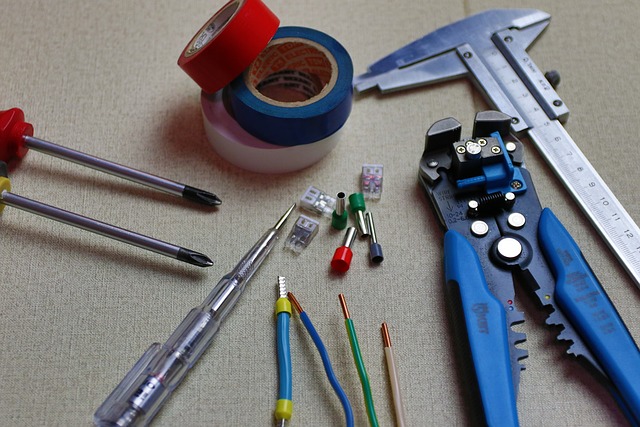Electricians address common issues like power surges and circuit overloads by identifying root causes—excessive power draw or faulty wiring—and implementing fixes for safe electrical systems. Homeowners can perform initial troubleshooting using tools like voltage testers and checking circuit breakers, but persistent problems require professional electricians to ensure safety and avoid further damage from hidden wiring issues.
Are you tired of flickering lights or circuit breakers tripping? Understanding common electrical malfunctions and knowing how to troubleshoot them can save you time, money, and potentially prevent hazards. This comprehensive guide equips homeowners with essential tools and safety precautions for diagnosing issues. From understanding faulty outlets to fixing a short circuit, we provide a step-by-step approach. Learn when it’s best to call a professional electrician for complex problems. Become your own electrical expert with these valuable insights!
- Understanding Common Electrical Malfunctions
- Tools and Safety Precautions for Diagnosing Issues
- Step-by-Step Troubleshooting Guide for Homeowners
- When to Call a Professional Electrician
Understanding Common Electrical Malfunctions

Electricians often encounter a range of electrical malfunctions, each with its own unique challenges. Understanding these common issues is the first step in effective troubleshooting. One of the most frequent problems is power surges, which can be caused by lightning strikes or high-power appliances and result in damaged equipment and frequent device failures.
Another prevalent malfunction is circuit overloads, typically indicated by flickering lights or electrical appliances that shut down unexpectedly. This occurs when a circuit’s capacity is exceeded, leading to overheating and potential fire hazards. Identifying the root cause—whether it’s an excessive power draw from multiple devices or a faulty wiring connection—is crucial for a electrician to implement appropriate fixes, ensuring safety and stability in your home’s electrical system.
Tools and Safety Precautions for Diagnosing Issues

When troubleshooting electrical malfunctions, the right tools and safety precautions are paramount for both efficiency and your protection. A seasoned electrician’s toolkit includes a variety of essential items such as voltage testers, multimeters, wire strippers, pliers, and flashlights. These tools enable accurate readings, precise measurements, safe cable manipulation, and clear visibility in tight spaces.
Safety should always be the top priority. Before beginning any electrical work, ensure proper grounding by connecting your tools to a grounded outlet or using a ground fault circuit interrupter (GFCI). Wear protective gear including insulated gloves and safety glasses. Additionally, power off the affected circuit at the main electrical panel to prevent accidents caused by live wires.
Step-by-Step Troubleshooting Guide for Homeowners

Step-by-Step Troubleshooting Guide for Homeowners
If you’re experiencing electrical malfunctions in your home, before calling an electrician, it’s helpful to have a systematic approach to troubleshooting. Start by identifying the specific issue—is the problem limited to one area or affecting the entire house? Check circuit breakers and fuse boxes; a tripped breaker or blown fuse is often the culprit behind power outages in specific circuits. Use a voltage tester to verify if there’s power reaching the faulty outlet or switch, helping you isolate whether the problem lies with external wiring or internal components.
Next, examine visible wires for signs of damage, exposure, or inappropriate connections. Look for loose connections at outlets, switches, and fixtures. Ensure that grounding is adequate and that all metal parts are properly connected to earth. If you’re comfortable doing so, try resetting the circuit by turning off the main breaker and then back on; this can often reset minor glitches. However, if issues persist or safety concerns arise, it’s best to contact a professional electrician for expert assistance.
When to Call a Professional Electrician

If you’re facing electrical issues at home, it’s natural to consider troubleshooting as a first step. However, there are certain situations where calling a professional electrician is crucial for your safety and to avoid further damage. Electrical malfunctions can be complex and varied; what seems like a minor issue could be a sign of a more significant problem lurking beneath the surface. Attempting to fix it yourself might seem appealing, but some issues require specialized knowledge and tools that are beyond the scope of a DIY project.
For instance, if you experience frequent power outages, flickering lights, or hear unusual electrical noises, these could indicate wiring problems or faulty installations. Additionally, if you’re dealing with outdated electrical systems or have added new appliances that exceed the capacity of your existing wiring, it’s best to consult an electrician. Their expertise ensures that any repairs are safe, up-to-code, and tailored to your specific needs, preventing potential hazards and costly mistakes.
Electrical malfunctions can cause significant disruptions, but with the right knowledge and tools, homeowners can often troubleshoot and fix these issues. Understanding common problems, adhering to safety precautions, and following a structured troubleshooting guide empowers you to tackle basic repairs. However, for more complex or potentially dangerous situations, it’s wise to remember that professional electricians are equipped to handle advanced electrical work. Don’t hesitate to call an electrician for expert assistance when needed.
